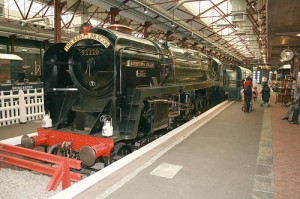Informal learning in apprenticeships
Here is the second in my series on informal learning. This is an extract from a a paper called ‘Rediscovering Apprenticeship?: A Historical Approach’ which I wrote in 1997. The paper, based on an interview with my father, provides a narrative account of an apprenticeship as a coach fitter in the Great Western Railway works in Swindon, England in the 1940s. The full paper can be downloaded at the bottom of this post.
“Apprentices were moved around between the gangs, usually spending about three months with a particular gang before the foreman would move them on. “Although it was not hard and fast we were moved in a fairly organised way. Apprentices always started on No 1 gang, which was a light job based in a siding outside the shop where we had to refurbish drop light windows. This meant removing the drop lights and the mouldings, which would be repaired inside, and then re-glazing the windows prior to fitting them back in the coach. After three months we were moved to a gang that undertook more complex work. The work got a little more complex with each move.
The chargeman for each gang was responsible for telling us what to do. Inside No. 7 shop we were mainly working on a bench. The men working on the next bench would show us how to do each job. When we were working outside the shop we were put with an individual tradesman who would teach us the job. Obviously some were better than others were”.
There was no written curriculum or even a list of skills or tasks that had to be learnt. “What we learnt depended totally on what a particular shop did. In fact our work was similar to a cabinetmaker. We were expected to achieve a tip-top finish. When we were working on the drop lights we would spend a whole day just sand papering – and then often the chargehand would make us do them all again. Time was not a problem – the question was quality”.
There were no written plans or procedures – learning was from practice. “Later I was sent ‘up the line’ to work outside the shop with the door gang. That was where I got my first interest in crossword puzzles. The tradesman was called Ted Quinn”. The door gang was responsible for hanging the interior doors in the carriages. “There is an art to hanging doors and making them slide – a knack to it. We had to screw a quarter inch rod with brackets above the door. The doors hang and rolled along the rod on wheels. If they were too high they would lift off the bottom guide rail, if they were too low they would stick or come off the rollers. Ted Quinn would get it right every time. He was fast enough that he would do a little work, then settle back to his crossword puzzles. If an apprentice mastered the skill he would be kept on the gang but some could never get the knack of it”.
New work, rather than repair and renovation, was highly regarded, mainly because it paid more. One of the best jobs was fitting the interior of compartments. This involved erecting the seats, interior panelling, mirrors, and putting up the net and blinds. Tradesmen would aim to complete one compartment each day. “Apprentices could be seen as a hindrance in this work – if you were not good you could slow the job down.” There were a number of specific skills to be mastered: “The best tradesman was a Hector Neaves. Everyone knew him as ‘one cut Neaves’. He would look at something and then cut a piece of wood which would fit first time nine times out of ten”.
There were no formal tests or assessment, neither was there any requirement to attend school. Those that did go to night-school could study for a National Diploma. This offered the opportunity on completion of apprenticeship to transfer to the Drawing Office, a position that was highly paid and the highest status. Many of the workers in the Drawing Office had passed their 11 plus and stayed on at school until the age of 16 prior to entering an apprenticeship. Few working class students went on to university. Other ‘grammar school boys’ joined the railway as clerks, a position which paid better and where they could “wear clean clothes”. Clerks also worked only 44 hours a week compared with 50 hours for tradesmen and labourers.”
Download the full paper here: apprenticeship_paper


[…] Pontydysgu – Bridge to Learning – Educational Research […]